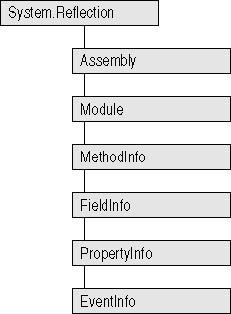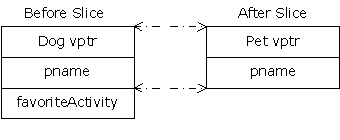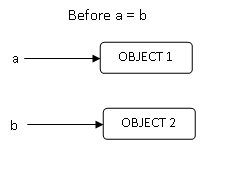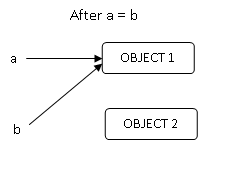CSC/ECE 517 Fall 2012/ch1b 1w40 as: Difference between revisions
| Line 68: | Line 68: | ||
[[File:Csharp.jpg]] | [[File:Csharp.jpg]] | ||
<b>Below are the several powerful reflection features that are provided by C#:</b> | <b>Below are the several powerful reflection features that are provided by C#:</b> | ||
Revision as of 01:48, 2 October 2012
Introduction
Reflection is a relatively common computer programming concept where in the program has the inherent ability to examine itself at run time. Based on its observations the program can modify it's behavior for the given situation.The modifications can be any aspect of the programming language .i.e syntax, semantics, or implementation. Precisely, "Reflection" can be defined as a language's ability to inspect and dynamically call classes, methods, attributes, etc. at runtime. More advanced uses of reflection let you list and call methods, constructors, etc.
Reflection is important since it lets you write programs that does not have to "know" everything at compile time, making them more dynamic, since they can be tied together at runtime. For example in a high level object oriented language the ability to inspect its class , interfaces and methods at run time without knowing their names at compile time. It provides the ability to modify , instantiate and access to methods such as getter's and setter's of a class. Since the program need not have all the information at compile time it makes the program more dynamic. The code can be written against known interfaces, but the actual classes to be used can be instantiated using reflection from configuration files. Lots of modern frameworks uses reflection extensively for this very reason. In scripting languages like Python reflection is even more tightly integrated, since it matches more naturally with the general programming model.
Reflection as a concept was first introduced in the doctoral dissertation of Dr. Brian Cantwell Smith<ref>Brian Cantwell Smith, Procedural Reflection in Programming Languages, Department of Electrical Engineering and Computer Science, Massachusetts Institute of Technology, PhD Thesis, 1982.</ref><ref>Brian C. Smith. Reflection and semantics in a procedural language. Technical Report MIT-LCS-TR-272, Massachusetts Institute of Technology, Cambridge, Mass., January 1982.</ref> in 1992.
In the simple illustration provided below in ruby we can see how the name of a class can be obtained from the object and how we can get the ancestor classes and modules of a particular class.
7.class #=> Fixnum "helloworld".class #=> String String.ancestors #=> [String, Enumerable, Comparable, Object, Kernel]
Some of the common information that can be obtained from reflection are :
- Object type
- Super classes of any class
- Methods
- class fields
- Interfaces
These are discussed in detail in the below sections. Common languages that exhibit reflection to varying degrees are Ruby, Java, Smalltalk, C# and more.
There are two basic types of reflection:
- Behavioral Reflection: This type of reflection changes the behaviour of the execution of the program based on observation and modification.
- Structural Reflection: This type of reflection deals with changing the very structure of the program such as the data structures and flow of control in the program.
Implementation
There are many challenges faced by designers of reflective languages. They must provide as much leeway as possible for late binging and at the same time they must optimize the compilation of the static components so that they are ready for run-time. Reflection is in essense a connection between the object-level (program) and meta-level (the processor). The ability of the object level to be able to observe and modify the meta-level information is the consequence of this connection. These actions can be termed as introspection (This involves the action of observing the class) and intercession (this involves the operation of modifying the behavior of the class). These actions can implemented with the implementation of the following components:
- Ability to create first class objects ie reification.
- Ability to convert a string that denotes a class or a method into its corresponding reference or invocation.
- Ability to use and create symbolic links to methods and classes.
Reflection in C#
Features
In C#, Reflection uses the type system. C# is a strongly-typed language in which every variable and constant has a type. Not only this, but every expression that evaluates to a value is also associated with a type. Every method signature specifies a type for each input parameter and for the return value. A typical C# program uses the types from the class library as an addition to the user-defined types that are specific to the program's problem domain.
C# maintains a special database called the ‘metadata’ where a compiled C# program is usually encoded and stored. This metadata can then be used by reflection to act upon and read the required data present in it. This provides astonishing features such as accessing the members of an object or class based on their string names. This can be done by using the System.Reflection namespace provided in C#.
As an example, the below program uses the System.Reflection namespace to access the metadata of itself. It searches for the public field with the name "_mynumber" and then acquires its value.
using System;
using System.Reflection;
class ReflectionUsage
{
public static int _mynumber = 4;
static void Main()
{
Type type = typeof(ReflectionUsage);
FieldInfo info = type.GetField("_mynumber");
object obj = type.GetValue(null);
Console.WriteLine(obj);
}
}
This program would then output the number ‘4’ which is the value that is assigned to the variable “_mynumber”.
Here is how the System.Reflection class contains in C#.
Below are the several powerful reflection features that are provided by C#:
Field Reflection: This gives the power to scan or search the fields in your C# program by using the GetField or GetFields methods. Using this reflection we can load field values and then loop through those fields and display their names and values. The System.Reflection namespace provides a powerful and maintainable way to enumerate fields and properties. It can then access these fields by name.
SetValue Reflection: SetValue accesses the fields by their names. We can take a string that usually represents a target field, and then using the System.Reflection namespace methods, change the actual value of that field. Below is an example that does precisely this:
using System;
using System.Reflection;
class ReflectionUsage
{
public static int _myfield;
static void Main()
{
FieldInfo info = typeof(ReflectionUsage).GetField("_myfield");
info.SetValue(null, 2012);
Console.WriteLine(_myfield);
}
}
The above program would output 2012 which is the value that we set using the SetValue reflection.
MethodInfo Invoke: Let us say we have the name of a method in the string format and want to invoke it. In such a case, one can use the GetMethod method and then invoke the MethodInfo that can be acquired from it. The invoke method can be called to invoke method with the name specified by the string.
Type Reflection: Type is one of the most important types when using reflection in C#. The Type type is used to describe data types. It stores the C# type information in a variable, property or field and can be used as an argument.
Sizeof: The sizeof operator exposes information about the implementation of types in the code. It does not require the System.Reflection namespace. However, it is related to reflection in the sense that it expresses information about the program itself.
Advantages:
1. In C#, one can write code that uses for example a System.Xml.XMLDataDocument class, which loads and parses an XML document and then allows you to parse the DOM during runtime. During parsing, every time that an <object> node is scanned, a new object needs to be created using its FQN (fully qualified name). Every time a <property> node is parsed, then its parent node's property needs to be set to a newly created object. Also, every time that a <function> node is parsed, the parent object that is created must have the function, by name, called on it using the arguments that are later defined. This would allow you to create any object type that you want, and set properties and call functions for initialization, in a very recursive manner. The use of reflection would render this code to be surprisingly small because it takes advantage of recursion and the generic nature of reflection.
2. Programs that use reflection have the ability to look inside themselves to see their own inner workings and structure. This capacity can lend them unique and powerful features that can be used to write better code.
Disadvantages:
1. One main disadvantage of using reflection would be that reflection in general is that they can render programs that are less clear to read, harder to understand. A new person reading the code can find it hard to grasp what the code is actually doing.
2. Another disadvantage is that it can render programs that are generally slower.
Reflection in Java
Reflection is a way of thinking; it's a metalanguage that enables you to analyze and manipulate your objects in a dynamic way. Once you see its possibilities, the sky's the limit: serialization, expression evaluation, language interpretation, class factories, object description, plug-in architectures - you name it. Reflection is one of the most exciting features of Java. Big industrial-strength protocols like SOAP and JavaBeans wouldn't be possible if it weren't for Reflection. Every time you drag-and-drop an object in your favorite IDE into a form, Reflection is orchestrating the action behind the scenes. Actually, most sophisticated Java applications rely on Reflection in one way or another. Reflection is an advanced feature of the Java environment. It gives runtime information about objects, classes, and interfaces. Reflection answers questions like: Which class does an object belong to? What is the description of a given class name? What are the fields in a given class? What is the type of a field? What are the methods in a class? What are the parameters of a method? What are the constructors of a given class?
Features
public class DemoClass{
public static void main(String[] args)
{
Class obtainClass = DemoClass.class;
String className = obtainClass.getName();
System.out.printf("ClassName: %s\n",className);
}
}
import java.lang.reflect.*;
public class DemoClass{
public String msg;
public DemoClass(String forMsg){
msg = forMsg;
}
public static void main(String[] args)
{
try{
Class obtainClass = DemoClass.class;
Constructor constructor = obtainClass.getConstructor(new Class[]{String.class});
DemoClass myDemo = (DemoClass)constructor.newInstance("Welcome to Java Reflection");
System.out.printf("New Instance String: %s\n",myDemo.msg);
}
catch(Exception e)
{
System.err.printf(e.getMessage());
}
}
}
Class objClass = MyObject.class; Field[] methods = objClass.getFields();
Class objClass = MyObject.class; Field[] methods = objClass.getMethods();
Advantages
1) One of the major advantage of Java reflection is in debugging. While debugging one should be able to examine the private members of classes. 2) Also while testing one should be able to enlist all members of class along with the relationship with superclass so as to ensure that all code branches are covered.
Disadvantages
1) Java reflection provides access to private variables and methods, this exposes the implementation of the class. Such use of class functionalities which break the abstraction can result is portability problems in future upgrades.
2) Reflection involves method execution which resolve at runtime, so with certain Java virtual machines which do not perform optimizations can result in performance overhead with use to Java reflection.
Dynamic binding : Making reflection possible
Ruby implements dynamic binding of objects. Dynamic binding plays a very important role in meta-programming.
In languages like C,C++; a simple assignment "a = b", would require 'a' and 'b' to be of the same type. The assignment is interpreted as copying b into a and is implemented by copying the contents of b into the space occupied by a. Thus if 'a' had been declared as an object whose memory size is less than b's object, then object slicing takes place i.e. only that part of 'b' which fits into a's memory would be copied. This behavior might lead to unintended consequences.
But dynamic binding in Ruby ensures that the type of object stored in a variable is determined at run time and not at compile time. Thus the assignment "a = b" is interpreted as binding 'a' to the same object that 'b' is bound to. It is implemented by copying the reference stored in b into the (pointer-sized) memory cell of 'a'. Thus 'a' and 'b' point to the same object after the assignment.
Symbols and their usage in reflection techniques
Basics
Symbols are objects used to represent names and strings inside a Ruby interpreter. They are immutable and remain unique i.e. every instance of a particular symbol is the same symbol.
Usage in reflection techniques
Symbols are widely used in reflection to invoke methods dynamically. Reflection methods like 'respond_to', 'send' make use of symbols as a reference to other methods. Strings can also be used in place of symbols. However symbols are more efficient compared to strings in terms of memory and performance.
Examples
Passing method by reference using a symbol
class Float
def poly
self*self*self + 2*self*self + 3*self + 4
end
end
And we can pass poly to an integration routine:
area = integrate(:poly, 0, 10)
Symbols in reflection
Send method
irb(main):015:0> to = [:to_s , :to_f]
=> [:to_s, :to_f]
irb(main):016:0> to.each{|method| puts "#{method} => #{5.send method}"}
to_s => 5
to_f => 5.0
=> [:to_s, :to_f]
respond_to method
5.respond_to? :slice #=> false 5.respond_to? :to_f #=> true
obj = Object.new if obj.respond_to?(:program) obj.program else puts "Sorry, the object doesn't understand the 'program' message." end
method_missing
Whenever a call to a method is made on an object , Ruby does a method look up. If the method is not found, Ruby calls a method named 'method_missing'. Ruby knows the existence of the 'method_missing' as all objects are instances of 'BasicObject' which includes 'method_missing'. The default behavior of BasicObject#method_missing is to respond by raising a NoMethodError.
Overriding 'method_missing' allows users to call methods that don't really exist. The example below illustrates overriding of 'method_missing' to the programmer's advantage. Ruby passes as parameters the name of the method called and the arguments passed to it.
Example1
class Cat
def mew
puts "Meow"
end
def method_missing(meth, *args)
puts "Sorry, I do not #{meth}"
end
end
c = Cat.new
c.mew
>>Meow
c.bark
>> Sorry, I do not bark
In the above example, as the method 'bark' does not exist, method_missing is called with the meth (method name as a symbol) :bark. Hence the result " Sorry, I do not bark "
Example2 Using method_missing to convert Roman numerals <ref>http://www.rubyquiz.com/quiz22.html</ref> to integers
class Roman
DIGITS = {
'I' => 1,
'V' => 5,
'X' => 10,
'L' => 50,
'C' => 100,
'D' => 500,
'M' => 1000,
}
def roman_to_integer(roman_string)
last = nil
roman_string.to_s.upcase.split(//).reverse.inject(0) do |memo, digit|
if digit_value = DIGITS[digit]
if last && last > digit_value
memo -= digit_value
else
memo += digit_value
end
last = digit_value
end
memo
end
end
def method_missing(method)
str = method.id2name
roman_to_integer(str)
end
end
Evaluating Roman.xix calls the xix method of module Roman. Roman has no xix method, so method_missing is invoked with :xix as the argument.The id2name method of class Symbol is invoked on xix returning "xix". The "xix" is then parsed according to the rules for evaluating Roman numerals, and evaluates to 19.
Example 3
class Performer
def method_missing(name, *args)
"The duck will #{name}: #{args[0]}"
end
end
duck = Performer.new
duck.sing("Quacking in the Rain") # => "The duck will sing: Quacking in the Rain"
duck.dance("Swan Lake") # => "The duck will dance: Swan Lake"
Applications of Reflection
- Reflection has become invaluable to programmers who need to connect code with data. For example in a GUI environment a button might need to invoke different methods in different classes. Reflection can be used here to call the method on any given class.
- Programmers who deal with a multitude of classes at the same time can use reflection to create a “serializer” that for a given class uses reflection to go through all the instance variables and processes them accordingly.
- Reflection is used in large test frameworks where reflection helps in identifying the test methods for different scenarios.
- Reflection provides the ability to morph the code based on dynamic situations. This provides a sense of artificial intelligence to the program as whole.
- Reflection can be used to debug and verify code as it provides access to the insides of a program.
- Reflection is very useful when the software is upgraded regularly. It provides an easy method to check for available methods and classes. This prevents the errors caused by the absense of methods and classes when they are deprecated.
Advantages and disadvantages of reflection
Advantages
- Extensibility: Reflection provides the capability of using external and user defined classes by instantiation of extensibility objects using their fully qualified names.
- Class browsers in IDEs: The ability to examine the members of classes makes implementation of visual aids , auto-completion and documentation easy in development tools for programmers.
- Debugging: Reflection allows the user to observe the private members in classes. This capability can be used to debug classes and their interactions.
- Test Harness : Reflection can be used to call a set of testing APIs defined on a class for maximum coverage of testing.
- Correctness : Reflection improves the robustness and the correctness of a program especially in dynamically typed languages as runtime checks can be added to check the availability of the methods or classes.
Disadvantages
- Reflection introduces lot of performance overhead when compared to non-reflective code. Hence it should be used judiciously.
- Since it provides access to the internals of a class or an encapsulated object security becomes a major issue.
- Since it is run-time binding we lose the security of compile time checks and verification.
Conclusion
This article makes an attempt to explain the concept of Reflection in Object Oriented Programming. The article mentions the different approaches to reflection in Ruby and other languages.It mentions the usage of Reflections and the advantages and disadvantages of using Reflection. A follow up to this article would be to study the concept of Metaprogramming.
References
<references/>



